The Downfall of the Urban Grocer
Joshua Strong
My father Michael, a 76 year-old Melbournian, remembers what it was like being sent to the grocer’s shop as a kid in the 1950s. “The basic staples were sold by weight”, he recalls. “You’d order half a pound of flour, and the attendant would measure it out on a scale and seal it up in a brown paper bag.” Even the biscuits were sold loose out of a large tin, and Michael knew how to double his yield: “The broken ones from the bottom of the tin were half-price, and the grocer would always have some set aside.” This recollection of a lost time comes to life through the images of grocer stores in the Jack Lockyer O’Brien collection, which shows the inner-Melbourne shopping economy before the glossy, uniform era of the supermarket. Hand-painted advertisements on the brick walls of shops almost exclusively promote Australian brands like Brooke’s Lemos Cordial and Bushells Tea. Independent hardware and shoe stores are dotted through the working-class streets, with their own branding artfully rendered on the brick facades. And within a convenient distance of every house, a grocer’s furnishing the essentials of daily life – all except one of which have since disappeared.
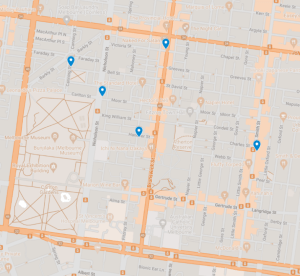
The metadata associated with these photos allows us to map a handful of these now defunct grocer’s stores in Fitzroy and Carlton alone, and trace what happened to the sites. An unnamed shop on the corner of Fitzroy and Hanover St, a short walk from the O’Brien’s house, was replaced by an apartment complex (Fig. 2). Seedsman’s store on the corner of Nicholson and Moor St, now a French restaurant specializing in duck. The store of B. Brescianini on Canning and Murchison in Carlton, a private house (Fig. 3). One-by-one, these stores were picked off and converted, as the phenomenon of self-serve supermarkets crashed into the local shopping economy from the 1960s.
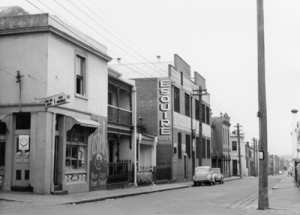

Not all the defunct grocers were independent corner stores – some were major economic players. The collection features images of Moran & Cato, which at its peak had over 35 stores across Melbourne, including a flagship on Brunswick St.1 As Michael remembers, Moran & Cato was such a mainstay of grocery shopping in those days, that its sudden demise would have seemed as inconceivable to locals then as would the overnight permanent shuttering of all Woolworths stores to the contemporary shopper. But shortly after these photos were taken, the modern supermarket, with its prepackaged self-serve offerings and undeniable convenience, posed a mortal threat to the established grocers.
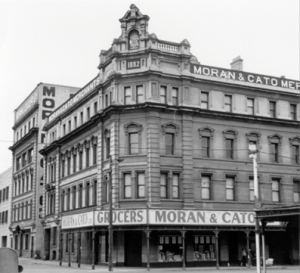
The directors of Moran & Cato had attempted to stay ahead of the game; in the mid-1950s they had already begun to transition their stores to self-serve.2 However, it was a store in neighbouring Collingwood, founded by GJ Coles as a nickel & dime in 1914, that would adapt best to the new shopping paradigm. Coles had been expanding and diversifying for decades, but it was not until 1960 that it launched its first freestanding supermarket.
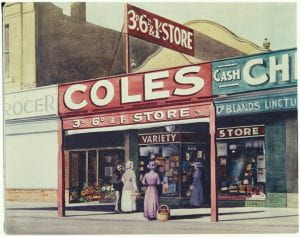
The Coles strategy of becoming a one-stop-shop for a family’s needs, coupled with its modern logistics and distribution systems, helped establish it as one of the two dominant supermarket chains in the country.3 Moran & Cato struggled to keep up, and by 1969 the Canberra Times was reporting that it was under threat of takeover due to “severe competition” from supermarkets. 4 Later that year, it was reported that the company had sold its stores to Permewan Wright Ltd – a chain that would itself cease to exist in the coming years. 5
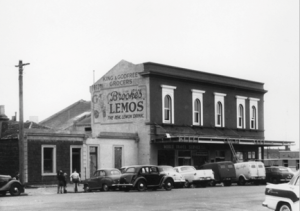
Among the grocers featured in the Jack L. O’Brien collection, there is one that did survive as an independent operator to this day. King & Godfree on the corner of Lygon and Faraday St has been in continuous existence for 150 years (see Fig. 6). After starting life as a standard grocer’s, the owners sagely began to stock Kosher products in the inter-war years, when Carlton became a centre of Jewish life in Melbourne.6 In 1934, the Jewish Weekly News was lauding the store for its efforts to “satisfy all wants of their Jewish clients for the coming Passover holiday.”7 With the large-scale Italian migration of the 1950s, the store was purchased by Carlo Valmorbida, who again adapted it for a new clientele. Author Michael Harden, who released a book in 2022 titled King & Godfree: The Corner Grocer, credits Carlo Valmorbida with introducing Melbournians to the delights of Italian food, transforming the way that we eat in the process.8 Carlo’s descendants still run the store, and King & Godfree is an entrenched Melbourne institution. The reason it survived while others failed was that it did not seek to compete with the supermarkets, but reinvented itself to offer more specialist products that the diverse population of Carlton couldn’t get elsewhere.

Surveying the Jack L. O’Brien collection has made me look more closely at the neighbourhood where I spent my young adult life. I find myself noticing the hand-painted advertisements for Bushells Tea and McAlpin’s Flour fading into the exposed brick of old grocery stores, or the prominent signage for Moran & Cato high up on a parapet above Brunswick St. Then I think of little Michael Strong, trundling home with a bag of broken biscuits and a big grin on his dial.
Joshua Strong is a PhD candidate whose research in historical studies focuses on the relationship between the architect and the state in Stalin’s USSR.
References
- E-Melbourne – The City Past and Present, Produced and published by the School of Historical & Philosophical Studies, The University of Melbourne, July 2008. Accessed September 3, 2023. https://www.emelbourne.net.au/biogs/EM01450b.htm ↩
- Self-service shops cut Moran’s profit (1955, November 26). The Argus (Melbourne, Vic.: 1848 – 1957), p. 20. Retrieved September 3, 2023, from http://nla.gov.au/nla.news-article71782528. ↩
- Coles – Our History webpage. Accessed September 3, 2023. https://www.coles.com.au/about/our-history ↩
- Permewan offers $11.6m cash for Moran & Cato (1969, May 22). The Canberra Times (ACT: 1926 – 1995), p. 28. Retrieved September 3, 2023, from http://nla.gov.au/nla.news-article131785828. ↩
- Moran & Cato says yes (1969, June 11). The Canberra Times (ACT: 1926 – 1995), p. 25. Retrieved September 3, 2023, from http://nla.gov.au/nla.news-article131789481. ↩
- King & Godfree kicks off 150th Celebrations with Julian Busuttil Nishimura (2021, September 15). The Sydney Morning Herald. Retrieved September 3, 2023, from https://www.smh.com.au/goodfood/eating-out/king–godfree-kicks-off-150th-celebrations-with-julia-busuttil-nishimura-20210914-h1yktd.html. ↩
- 50th Anniversary. (1934, February 23). The Jewish Weekly News (Melbourne, Vic: 1933 – 1935), p. 9. Retrieved September 3, 2023, from http://nla.gov.au/nla.news-article262464598 ↩
- Interview with Michael Harden. (2022, December 7). Melbourne Food & Wine Festival website. Accessed September 3, 2023, from https://www.melbournefoodandwine.com.au/read-watch/latest-news/news/buy-the-book-king-godfree-the-corner-grocer-1332. ↩
Leave a Reply